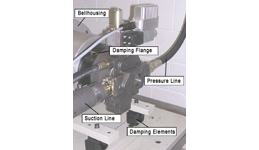Why would users experience noise from the Radial Piston Pump (RKP)?
The RKP pump has a reputation of being one of the quietest pumps in the marketplace, but occasionally users may experience a noise problem that is often due to installation issues.
There are two factors to be considered when looking at a noise problem. The first is intermittent internal forces caused by the reversing of a piston from the suction side to the high-pressure side of the RKP pump. This repeated loading results in a mechanical energy, which eventually radiates through the housing of the pump as air-borne noise. This intermittent internal force can cause some mechanically coupled system components to vibrate and subsequently produce structure-borne noise.
The other factor is the acoustic pressure wave produced by the compression of the hydraulic fluid. The resulting delivery flow from the RKP pistons will include a pulsation. This pressure ripple transfers fluid-borne noise into the hydraulic circuit and, if allowed to propagate, can stimulate other parts of the system to which eventually radiate the energy as noise.
Again, the end-user should establish if the problem is radiated noise through the housing or structural resonances of the system.
What can a user do to prevent structure-borne noise?
To prevent structure-borne noise in a machine, it is necessary to decouple the pump from the machine structure. Moog frequently recommends a damping or anti-vibration flange between the pump and the electric motor and a soft coupling between the pump-to-motor drive shaft interface. The power unit (pump and electric motor) should be mounted with rubber, grommetlike supports at a stable and solid part of the machine framework. The discharge pressure line from the pump should be a flexible hose mounted with a wide bend. The high-pressure lines from the manifolds to the actuators should be fixed to the system by means of rubber clamps.

What are some solutions for fluid-borne noise?
To prevent fluid-borne noise from affecting other parts of the machine, Moog again recommends rubber damping elements (e.g. elastomeric isolation mounts or resilient pads) under any manifold at a stable part of the framework.
Some additional broadband noise may be present due to mechanisms such as cavitation, turbulence, and unstable pump compensators. Elimination of these problems will further minimize a secondary noise source. The suction line should be a short hose of sufficiently large diameter without any filters, check valves, and/or sharp edges.

